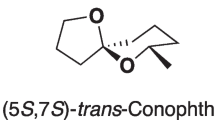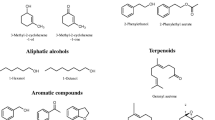Abstract
A mycangial symbiotic fungus ofDendroctonus frontalis is capable of oxidizingtrans-verbenol to verbenone. Both of these compounds are known to be important behavioral chemicals for this species, and it is suggested that development of the fungus in the plant host may play a role in influencing the behavior of the beetle to a successfully colonized tree.
Similar content being viewed by others
References
Barras, S.J. 1973. Reduction of progeny and development in the southern pine beetle following removal of symbiotic fungi.Can. Ent. 105:1295–1299.
Barras, S.J. andPerry, T. 1972. Fungal symbionts in the prothoracic mycangium ofDendroctonus frontalis (Coleopt.:Scolytidae).Z. Angew. Ent. 71:95–104.
Barras, S.J. andTaylor, J.J. 1973. VarietalCeratocystis minor identification from mycangium ofDendroctonus frontalis.Mycopath. Mycol. Applic. 50:293–305.
Borden, J.H. 1974. Aggregation pheromones in the Scolytidae, pp. 144–145,in Birch, M.C. (ed.),Pheromones, North-Holland Publishing Co., Amsterdam.
Brand, J.M., Bracke, J.W., Markovetz, A.J., Wood, D.L., andBrowne, L.E. 1975. Production of verbenol pheromone by a bacterium isolated from bark beetles.Nature 254:136–137.
Fonken, G.S. andJohnson, R.A. 1972.Chemical Oxidations with Microorganisms, pp. 1–112. Marcel Dekker, Inc., New York.
Happ, G.M., Happ, C.M., andBarras, S.J. 1971. Fine structure of the prothoracic mycangium, a chamber for the culture of symbiotic fungi in the southern pine beetle,Dendroctonus frontalis.Tissue and Cell 3:295–308.
Howe, V.K., Oberle, A.D., Keeth, T.C., andGordon, W.J. 1971. The role of microorganisms in the attractiveness of lightning-struck pines to southern pine beetles.West Ill. Univ. Ser. Biol. Sciences 9:1–44.
Hughes, P.R. 1973a. Effect of α-pinene exposure ontrans-verbenol synthesis inDendroctonus ponderosae Hopk.Naturwiss. 60:261–262.
Hughes, P.R. 1973b.Dendroctonus; Production of pheromones and related compounds in response to host monoterpenes.Z. Angew. Ent. 73:294–312.
Hughes, P.R. 1975. Pheromones ofDendroctonus: origin of α-pinene oxidation products present in emergent adults.J. Insect Physiol. 21:687–691.
Prema, B.R. andBhattacharyya, P.K. 1962. Microbial transformation of terpenes II. Transformations of α-pinene.Appl. Microbiol. 10:524–528.
Renwick, J.A.A. 1967. Identification of two oxygenated terpenes from the bark beetlesDendroctonus frontalis andDendroctonus brevicomis.Contrib. Boyce Thompson Inst. 23:355–360.
Renwick, J.A.A., Hughes, P.R., andTy, T. DeJ. 1973. Oxidation products of pinene in the bark beetle,Dendroctonus frontalis.J. Insect Physiol. 19:1735–1740.
Renwick, J.A.A. andVité, J.P. 1970. Systems of chemical communication inDendroctonus.Contrib. Boyce Thompson Inst. 24:283–292.
Rudinsky, J.A., Morgan, M.E., Libbey, L.M., andMichael, R.R. 1973. Sound production in Scolytidae: 3-methyl-2-cyclohexen-1-one released by Douglas-fir beetle in response to male sonic signal.Environ. Entomol. 2:505–509.
Rudinsky, J.A. andMichael, R.R. 1974. Sound production in Scolytidae: ‘rivalry’ behaviour of maleDendroctonus beetles.J. Insect Physiol. 20:1219–1230.
Rudinsky, J.A., Sartwell, C., Jr., Graves, T.M., andMorgan, M.E. 1974. Granular formulation of methylcyclohexenone: and antiaggregative pheromone of the Douglas fir and spruce bark beetles (Col., Scolytidae).Z. Angew. Ent. 75:254–263.
Author information
Authors and Affiliations
Additional information
Supported in part by a cooperative agreement with the USDA Forest Service, Southern Forest Experiment Station, Pineville, Louisiana 71360.
The use of a trade name in this paper does not constitute an official endorsement or approval by the USDA.
Rights and permissions
About this article
Cite this article
Brand, J.M., Bracke, J.W., Britton, L.N. et al. Bark beetle pheromones: Production of verbenone by a mycangial fungus ofDendroctonus frontalis . J Chem Ecol 2, 195–199 (1976). https://doi.org/10.1007/BF00987742
Received:
Revised:
Issue Date:
DOI: https://doi.org/10.1007/BF00987742




